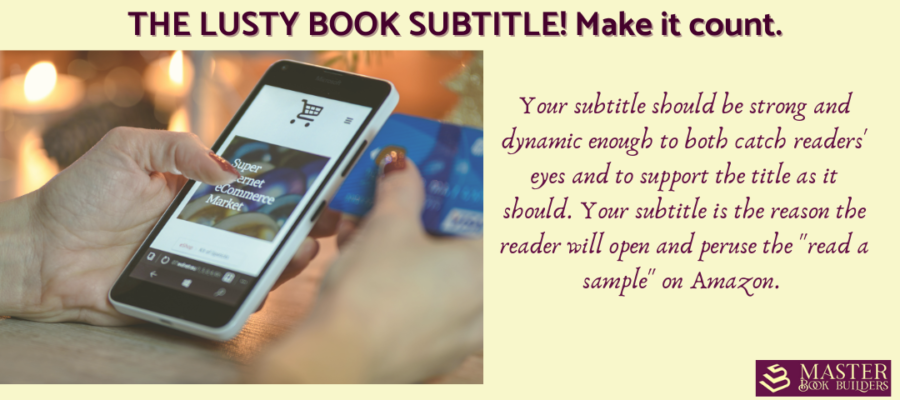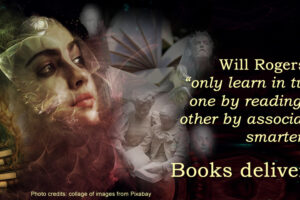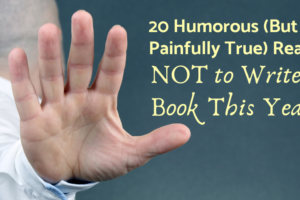Presenting, the Amazing, Lusty Subtitle! A book’s best friend!
Amazon sells more than 300 million books a year. And…
The controversy over whether to publish your book on Amazon or to list it there continues. But in our world, the world of books and authors, Amazon is the largest bookstore in the world, and since it purchased Audible, it has become the largest audiobook retailer on the planet.
Facing facts, we know that Kindle dominates the Indie market. Since we work primarily with indie-published authors, I thought we should talk about standing out – on Amazon or anywhere else.
How do you stand out?
First, you create a great title. Work it. Don’t accept the first thing that comes out of your head. You may decide that is the best title, but play around with some alternatives. It’s best to keep it short, snappy, and easy to read in a thumbnail image.
And then, there’s more work after that.
There’s the lusty subtitle.
Yes, you should think of your subtitle as lusty! Powerful! Dynamic! Strong!
Strong and dynamic enough to both catch readers’ eyes and to support the title as it should. Your subtitle is the reason the reader will open and peruse the “read a sample” on Amazon.
It’s also the reason you wrote the book. A subtitle can be the text that explains your purpose, why the book is important, and what it will do for the reader if she reads it.
Because the reader needs convincing.
Remember, you’re competing with thousands, hundreds of thousands, of other books. If you’ve chosen your categories correctly, your book will have a chance to be #1, at least for a time. And that is important. Amazon respects titles that reach #1 status, even for one day.
If it gets to #1, I’m here to say it had better have a great title, book cover, and subtitle. Because those are the things people see first.
Ingram Spark gives great advice on choosing subtitle, but it’s heavy on memoirs and fiction. Somehow, the world of nonfiction continues to lurk in the shadow of fiction. The world is gaga over fiction and merely tolerant of nonfiction. Unless you’re writing nonfiction and/or in need of the advice, education, inspiration of a nonfiction book.
Here’s a bit of advice from Brooke Warner, writing about subtitles on Ingram Spark.
- The biggest mistake I see authors making where subtitling is concerned is having book subtitles that are long but not clever. They may speak to things that happen in the book rather than themes, or to random asides rather than the core ideas. Don’t do this.
- Remember that your reader has no context for the intricacies of your story when they’re browsing in the bookstore or online.
Notice the word ‘themes’. In choosing a subtitle, it does pay to understand themes. Themes require the subtitle to match the content in the book.
The book has a theme. A throughline. A purpose. Do the title and subtitle match what’s in the book? Or is the subtitle outrageously loud and pushy – trying to do something it can’t? In other words, is the subtitle making promises about what’s in the book only to leave the reader disappointed because the content in the book didn’t fulfill the promise?

Here are a few ways subtitles enhance the value of your book – remembering that your reader’s attention span is limited. In a moment, we’ll talk good subtitles and bad subtitles.
- The subtitle clarifies the book’s focus
- It captures reader interest
- It communicates a benefit
- If done right, using keywords properly, the subtitle enhances searchability (yes, there’s that word again, keywords – you must keep them in mind for your title and your subtitle, but they are secondary to the purpose of the book)
- It can establish expertise
- It differentiates you from competitors
- It can engage emotion – make me feel something
- It completes the title
Choosing a Good Subtitle Requires…
Notice I said choosing, not creating or crafting. You will create or craft your subtitle over and over. This task is often harder than the title. The subtitle carries so much weight, writers often spend hours, days, weeks, writing it over and over.
And that’s good. Do that. Create many subtitles. Do your homework. Review other subtitles in your genre. Just as you did for your title. Make sure you’re paying attention to core audience and the throughline of your book.
Don’t get too flowery. By that I mean don’t overdo the humor, or cuteness, or information you’re sharing in the subtitle. Keep it simple and try to be subtle, if you can. Yes, there are times when cute and funny work, but be sure of your message before resorting to those tactics.
Let’s look at some not so good subtitles. And then some very good subtitles. I will say one more thing, sometimes the ‘good’ of a subtitle and the ‘bad’ of one are relative. To whomever is looking at the book at that moment. The goal here is to give you examples to think about.
And understand that today, even some fiction books come with a subtitle. Certainly books in a series include a subtitle, the better to convey which book in the series it is.
Bad Subtitle Examples
First, let’s define a bad subtitle. Once again, we’ll say pay attention to themes. This means, staying true to the book’s content. Don’t make promises you can’t keep. Don’t throw a keyword phrase together just for the sake of the SEO value. Keep your tone relevant to the book’s purpose. And make sure the subtitle you chose four months ago, matches the book you just completed today!
Now, let’s look at a couple of poorly written subtitles: (it seems the web is full of bad title advice, but not so focused on subtitles; that concerns me – because subtitles are so important!)
Slave in a Box: The Strange Career of Aunt Jemima by Maurice M. Manring. This noted book about Aunt Jemima fails in its subtitle because there is nothing ‘strange’ in the story. The subtitle would have us believe this is a biography, which is what I thought. But, it isn’t, really. What word would you have used to better describe a book about racial oppression and class identity?
What about this – Play Big: Lessons in Being Limitless by Jen Welter. What is that book about? Would you pick it off the shelf? It’s a look at Welter’s life as a linebacker coach for the Arizona Cardinals. The first woman to break that glass ceiling. A worthy accomplishment but the title and subtitle could have been so much more purposeful. The cover desgin saves this book because Jen is featured and makes the book more intriguing. But it still doesn’t ring my bell – the subtitle doesn’t match the title or the book’s content.
And how about this? Erin McHugh’s Political Suicide: Missteps, Peccadilloes, Bad Calls, Backroom Hijinx, Sordid Pasts, Rotten Breaks, and Just Plain Dumb Mistakes in the Annals of American Politics. How long did it take you to read that? And did you just give up?
Try not to make your subtitle so long it falls of the margin of the book. And, by the way, now that we’re talking about that, when you think you have the perfect subtitle, get your book cover designer to create a mockup of your cover, with the subtitle. How does it look? Is it too long? Is it too short? Does it just not sit right? Design plays a big part in this part of your book.
Yes, Amazon does allow up to 199 characters for a book’s title and subtitle combined, which gives you a lot of leeway, but don’t do it just because you can.
Ready for some GREAT Titles and Subtitles?
☑ Neil deGrasse Tyson’s book Starry Messenger: Cosmic Perspectives on Civilization
☑ Leading Women: 20 Influential Women Share Their Secrets to Leadership, Business, and Life by Nancy D. O’Reilly, PSYD
☑ Angela Ackerman’s and Becca Puglisi’s The Emotional Thesaurus: A Writer’s Guide to Chacter Expression
☑ And, our own, The HOW TO WRITE A BOOK Book: Your Step-by-Step Plans for Bringing BIG IDEAS to Life One Page at a Time
Now, perhaps you would like to share your book title and subtitle in the comments? It’s never too soon or too late to make those important elements of your book the best they can be.
Connect with me on LinkedIn. Remember, Good Things Come To Those Who Write.






Leave a Reply